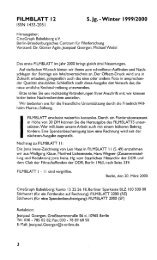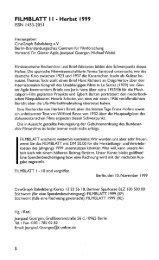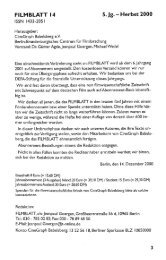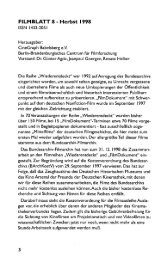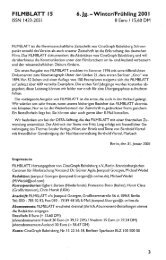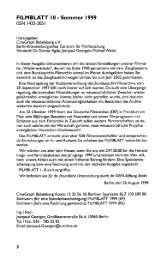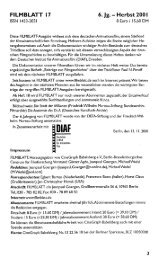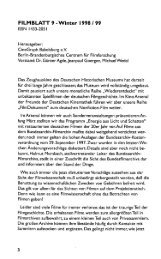Frühling/ Sommer 1998 - Filmblatt
Frühling/ Sommer 1998 - Filmblatt
Frühling/ Sommer 1998 - Filmblatt
Sie wollen auch ein ePaper? Erhöhen Sie die Reichweite Ihrer Titel.
YUMPU macht aus Druck-PDFs automatisch weboptimierte ePaper, die Google liebt.
ist das Einseifen beim Barbier von gradezu überwältigender Komik: Ein Herr<br />
sitzt zurückgelehnt auf dem Stuhle: vor ihm steht der mit Seife und Pinsel<br />
bewaffnete Barbier und waltet seines Amtes. Seitwärts zieht der Gehilfe das<br />
Messer auf dem Streichriemenab. Das langsame Hin- und Herfahren des Mes¬<br />
sers auf dem Riemen, die Körperbewegung des einseifendenBarbiers und das<br />
Fingerspiel des Eingeseiften sind von unübertrefflicher Naturtreue."(Photo¬<br />
graphische Rundschau, 1895, 1. Heft, p. 27) This picture series is unique<br />
amongstall of the Anschütz lebende Bilder. It used the most elaborate set<br />
and collection of properties. It requiredsignificant rehearsal and dose direction<br />
of its players, as always with the requirement that the movements be<br />
precisely cyclical, so that the rotating disks of the Anschütz apparatus (the<br />
machineused two disks, two lamps,two lenses and one blending shutter designed<br />
after dissolving magic lantern shutters) would present and re-present<br />
the movement without any jump in the action.<br />
It is also unique amongstthe Anschütz entertainment series in that its subject<br />
does not fall into a well-known or widely recognized Strand of short comic<br />
scenes or transformations and does not belong to a generic entertain¬<br />
ment activity like the series of boxers.<br />
What motivated Anschütz to make this subject? In my opinion, Anschütz<br />
heTe is producing a consciousre-make of the Edison kinetoscope film The<br />
Barber Shop, which was made in the Black Maria sometime before the end of<br />
1893. For all of his technical innovations in both photography and chronophotography,<br />
Ottomar Anschütz was a photographer primarily devoted to the<br />
excellence of his images. He was obsessed with picture quality, and continuously<br />
exhibitedbefore the photographic associations in Berlin, Frankfurt,<br />
Vienna, London and elsewhere chronophotographs of horses and athletes so<br />
that they could be directly comparedwith similar work from Eadweard Muybridge<br />
and Etienne-Jules Marey. In this comparison, any judgementabout<br />
picture quality always went in favor of Anschütz.<br />
The receivedlegend about why Anschütz never worked with celluloid film<br />
bands like Marey and Georges Demeny, or, in the end, Thomas Edison with<br />
his Kinetoscope,is that „on principle" Anschütz preferred to use German materials<br />
and there were no German manufacturers of celluloid films at that<br />
time. (Oskar Messter, Ottomar Anschütz zu seinem 90. Geburtstag, In: Die Ki¬<br />
notechnik, 20 April 1936, p. 126)<br />
But it is much more likely that Anschütz remained committed to his larger<br />
individual photographic plates, instead narrow celluloid film because he<br />
knew that the quality of his images were vastly superior to anything that he<br />
could obtain on celluloid, and because he knew that celluloid film in the early<br />
1890s was photographicallyinferior to his plates. So it is more than likely<br />
that Anschütz kept to his old methods, which were well proven over the pre-<br />
24



